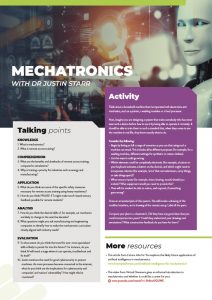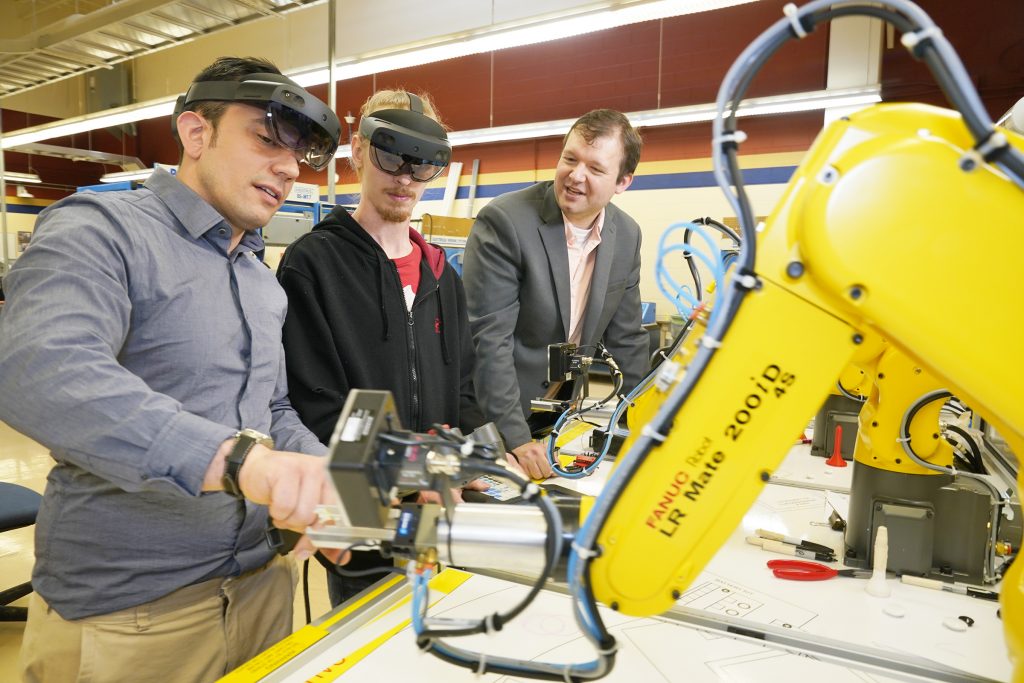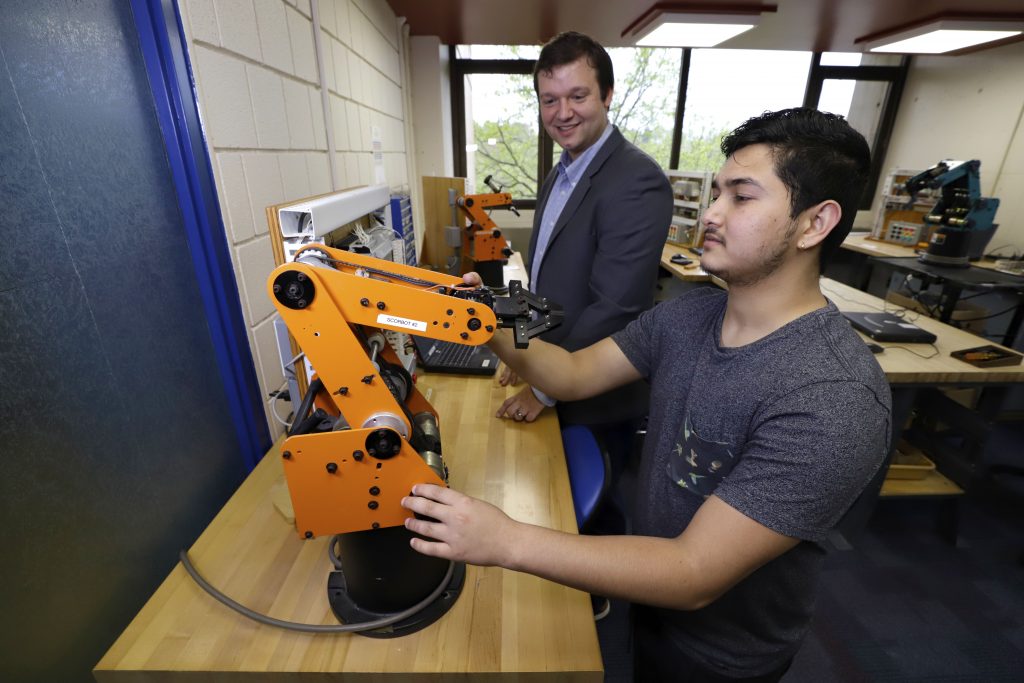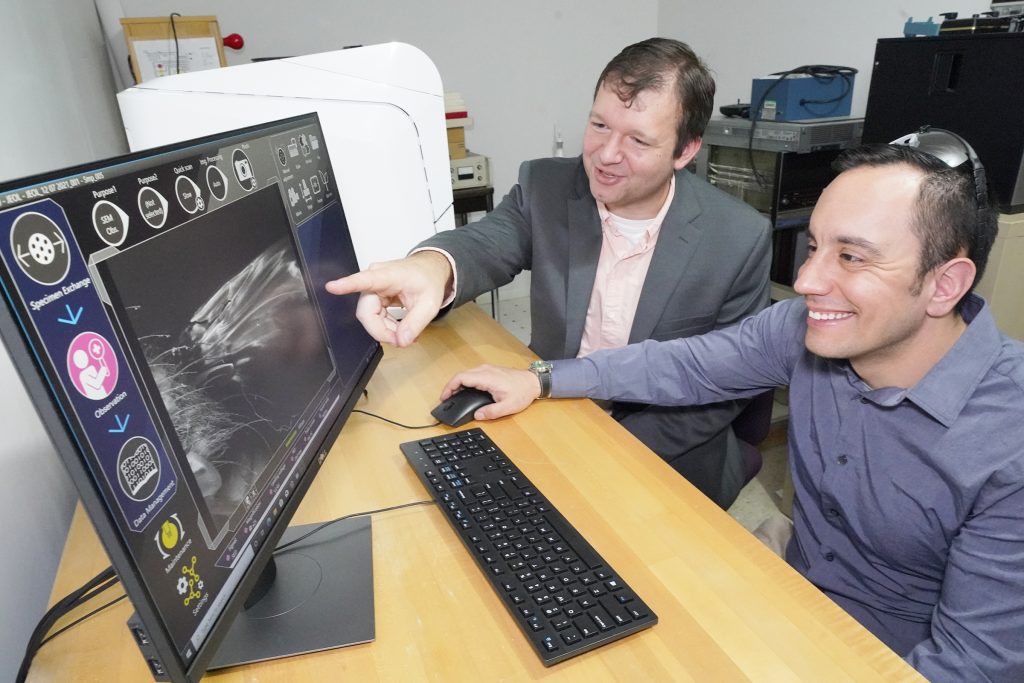Controlling machines from afar
Industrial machines are at the heart of today’s economy and society, but training people to use them is a challenge. It is not possible for many students to be physically present to operate such machines, including learners in rural areas or those without access to transportation. Based at the Community College of Allegheny County (CCAC) in the US, Dr Justin Starr’s PRAISE-ET programme is changing this by providing remote access to industrial and scientific equipment, making mechatronics more accessible than ever.
TALK LIKE A MECHATRONICS ENGINEER
Hydraulic system — a system that uses pressurised fluids to drive its movements
Logic controllers — a computer adapted for the control of manufacturing processes
Mechatronics — a field that combines the studies of electronics and mechanical engineering
Simulation — a model that mimics the behaviour of something real
The rise of machines has brought countless benefits to society as we are able to make and process things that would never be possible by human hands alone. However, as machines become increasingly sophisticated, the skills needed to operate them become increasingly specialised. A shortage of such skills is a real concern, especially for emerging industries such as renewable energy technologies and autonomous vehicles. A lack of technicians with the right experience could significantly inhibit their progress and development.
Development of these skills requires real, hands-on experience. “When receiving training in fields like manufacturing, learning how to properly use equipment is essential,” says Dr Justin Starr, Endowed Professor of Advanced Technology at the Community College of Allegheny County (CCAC). “It’s not possible to work with advanced robotic systems, programmable logic controllers, or hydraulic systems without first-hand experience operating and controlling these devices.”
Place-based learning
Due to the nature of industrial and scientific equipment, the challenge with this training is that it has to be ‘real’. Learning the theory from a textbook is not enough. “Historically, this training has been limited to people who can attend in-person training sessions,” says Justin. “But this isn’t easy or even possible for many. For instance, people from rural communities, working parents and differently abled individuals.”
To solve this issue, Justin is working on systems to enable students to operate real-life machinery from anywhere with an internet connection. The project, Providing Remote Access to Industrial and Scientific Equipment for Engineering Technologies (PRAISE-ET), is using a wealth of clever technologies to make the process as close to an in-person experience as possible.
PRAISE-ET
“Making labs compatible with a remote access format involves making extensive modifications to incorporate the unique features of a remote control scheme,” says Justin. This might involve linking up buttons to be electronically – rather than physically – activated, installing robotic arms to operate levers or hydraulic systems, and installing cameras and other equipment necessary for the sensory experience.
“We are one of the only projects that tackles this challenge,” says Justin. “We use a variety of equipment such as collaborative robots, 3D printers and custom control interfaces.” Such systems have allowed students in remote locations to learn how to operate sophisticated machines and enabled students to operate different machines in other places.
“In a remote robotics class, students in Pennsylvania were able to control a robot located in Missouri and gain experience with different equipment to the one used in the college,” says Justin. “Elsewhere, in introductory 3D printing classes, lessons normally available to a few dozen in-person students were instead accessed by hundreds of online students, who could all earn industry certification.”
Simulation limitations
Would it not be easier to build a computer programme with all the same controls as the machine, so students can ‘pretend’ to use it without needing to actually operate any machinery? “For many years, simulation has been touted as an effective training tool, but it doesn’t come close to a real experience,” says Justin. “For instance, while a simulated programme may be able to replicate the buttons on a keypad, it doesn’t involve the tactile feel of different controls, or the sounds associated with things going smoothly – or not.”
There are also challenges in anticipating the range and randomness of potential failures when programming a simulation. “Fault simulators often replicate failures in ways that are too predictable and struggle to truly simulate intermittent errors,” says Justin. “Students will learn to identify the patterns of the simulation and are ill-equipped to recognise truly random faults caused by physical issues in the real world.”
Sensory aspects
Remote access technologies do not rely on simulations; they involve students actually operating the physical machine, albeit from a distance. “A truly effective remote access tool will enable a student to control a piece of equipment as effectively as if they were there in person,” says Justin. However, the experiences of being physically there, as opposed to working from afar, will inevitably be different, which is why Justin is working on clever technologies to make the two experiences as alike as possible.
Reference
https://doi.org/10.33424/FUTURUM374
CCAC Mechatronics instructors prepare a lab exercise using the college’s Scanning Electron Microscope to observe a material failure in ultra high resolution.
(All photos: Community College of Allegheny County)
Transmitting the ‘feel’ of the machine’s operation is crucial and is something that simulations cannot do. “These remote access systems should provide multiple sensor data streams to learners,” says Justin. “This includes visual data from cameras, audio feeds, haptic (touch-based) feedback and other sources of information.” Combining all these inputs helps learners get a deeper understanding of a piece of equipment: how it responds to different inputs, what different sounds, vibrations and moving parts mean, and how to identify if something is going wrong. CCAC worked closely with a partner company to develop a custom hardware interface to provide this critical functionality. That company, RealBotics, has pledged to make hardware developed under this grant available to other colleges and universities at an extremely low cost. RealBotics founder and CEO, Christopher Quick, commented that “developing this hardware fills a critical role that dates back to the time when I was a student. Working with CCAC will help us make this technology available to users around the world.”
Safety
Despite their drawbacks, simulations do have one advantage: safety. If a simulation is incorrectly operated, nothing bad actually happens. When real machines are involved, something going wrong can have real-world impacts. People in the same location as the equipment could be injured, or the machine might need pricey parts replacing. “Enabling students to control expensive, heavy, rugged pieces of equipment via the internet is inherently challenging,” says Justin. “Establishing safety protocols to protect people and equipment is vital.”
The introduction of an internet connection also raises its own unique issues. “Systems must be hardened to protect from hackers, as well as other faults,” says Justin. “For instance, lag or poor-quality data transfer might make it harder to respond correctly in real-time.” Solving these issues requires an alliance of many different specialities, from mechatronics to cybersecurity, but the benefits of such a system are clearly demonstrable.
Linking up
Justin is also passionate about making such technologies available for everyone. “All of the lessons, support materials and code we’ve developed are available to institutions at no cost,” he says. “We’re hoping that our hard work to make remote access technology more available will be used by institutions around the world.” Unique collaborations have already sprung up between CCAC and other universities, which has opened up opportunities for students to explore transfer options when they finish their studies at CCAC. “We believe these guided pathways and informal learning experiences are critical to encouraging students to continue their education, even if they’re enrolled in career-oriented programmes,” says Justin.
Equipping students with skills for careers in industry is always at the forefront of Justin’s mind. Unsurprisingly, the COVID-19 pandemic accelerated a lot of the technologies necessary for such systems. “The pandemic led to many manufacturing facilities transitioning to distributed teams for maintenance,” says Justin. “While one person might be physically there, their teammates can support by dialling in remotely.” The rise of remote access communication, and operation of tools themselves, has paved the way for accessible training methods.
This development has been integrated into the PRAISE-ET programme. “We work closely with the Advanced Manufacturing Business and Industry Leadership Team (BILT) to ensure that our developed technologies align closely with regional needs,” says Justin. The BILT has helped recommend further modifications, such as ways for students to remotely collaborate on machine operation, and the integration of augmented and virtual reality. “Companies are also invested, such as by donating equipment to allow for the design of custom remote-access equipment,” says Justin. The programme aims to expand to a number of partner institutions, to create the next generation of skilled technicians and engineers who are fully equipped for a rewarding career in industry.
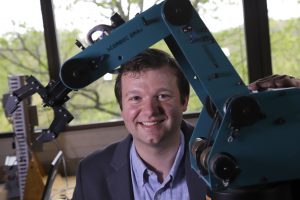 Dr Justin Starr
Dr Justin Starr
Endowed Professor of Advanced Technology, Community College of Allegheny County, Pittsburgh, Pennsylvania, USA
Field of research: Mechatronics
Research project: Providing Remote Access to Industrial and Scientific Equipment for Engineering Technologies (PRAISE-ET)
Funders: US National Science Foundation (NSF), Division of Undergraduate Education (award number: 2055714)
ABOUT MECHATRONICS
Mechatronics is an interdisciplinary branch of engineering that combines mechanical and electronic engineering systems. Its broad aim is to integrate different types of engineering to study and develop fields such as robotics, computer science and manufacturing. It has strong practical applications and is driving the progress of technological developments and rollouts. Justin explains more about his field and why it will be ever-more critical in the future.
“Mechatronics is at the core of advanced manufacturing. It’s awesome to work in a field that’s being used every day by companies critical to the national economy. The skills that our students learn can be deployed immediately. This is in contrast to many other fields, where there’s a lag between advancement and application. Innovations in materials science, for example, may not be used in products for many years. The lag for mechatronics is almost nothing, which means there’s never a dull moment.
“While many of us think of artificial intelligence (AI) as a tool for the future, it’s rapidly becoming part of our lives. We’re already seeing the deployment of advanced AI tools like ChatGPT and Stable Diffusion. Today’s technicians will be working with AI in the next three to five years, so knowing how it works and how to use it will be a huge benefit for careers.
“Documenting your work is important, even if you only consider it your hobby. Make a digital portfolio to showcase your work, interests and passions to future employers. Even projects you do for fun show a lot about how you acquire knowledge and solve problems – they are just as important, if not more so, than your school assignments.”
Explore careers in mechatronics
• The CCAC welcomes visitors for lab tours and shadowing current students and provides opportunities to use their technologies. It also offers low-cost training in programming, 3D printing, robotics and introductory mechatronics. Find out more and get in touch.
• The CCAC has a mechatronics programme for high school students, providing an introduction to the field along with industry-recognised certification.
• According to Talent.com, the average mechatronics engineer salary in the USA is $100,000 per year.
Pathway from school to mechatronics
“Mechatronics is an integrative field, so knowing a bit about lots of things will be tremendously valuable,” says Justin. He recommends studying mechanical systems, electronics and physics as the core of ‘traditional’ mechatronics. In addition, he says that learning coding and app development will be critical to use software to automate tasks and advance the field.
Meet Justin
I was always a collector and tinkerer. When growing up, I liked taking things like old TVs and seeing if I could fix them. I ended up saving a lot of old components and built up a really useful set of electronic supplies. I also enjoyed music, reading and travelling to new places.
I had no idea what I wanted to be when I was younger. I fell into engineering, in fact. When I was an undergraduate student, I took a year off from studying to work for a startup that made sewer inspection robots. I loved the intersection of technology and business and returned to the company many years later to work as the Chief Technology Officer and, ultimately, sell the business. These experiences in industry have been vital to becoming an effective educator in the field.
If something seems impossible, just keep trying. If you don’t have the funds for a project, apply for a grant or work with local resources. Most importantly, be nice to people and help them succeed. Teamwork is essential to solve the most challenging issues in any workplace.
I believe in sharing the credit for success. Whenever projects go well, I try to let others take the credit. I want to be viewed as successful because the people around me are successful. Being someone who facilitates success makes others want to work with you.
I was honoured to be named an Engineering Unleashed Fellow for my work integrating Entrepreneurial Minded Learning into the mechatronics curriculum. I’m also proud of the work of the CCAC on a number of projects linking learning with industry, and we’ve successfully involved local employers to guide curriculum updates for our mechatronics programme. We’ve also provided high schools with advanced manufacturing equipment, to produce a pipeline of students from an early age.
In my free time, I enjoy hiking and spending time with my wife and young son. I also restore computers from the 1970s and 80s, and tinker with old Volvo cars.
Never stop learning. The pace of technological progress is relentless. Working in mechatronics involves staying on top of these developments. If being on the cutting edge excites you, then mechatronics is an extremely rewarding field.
Do you have a question for Justin?
Write it in the comments box below and Justin will get back to you. (Remember, researchers are very busy people, so you may have to wait a few days.)


